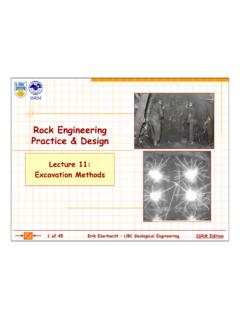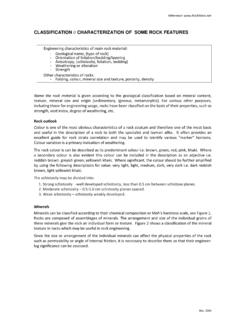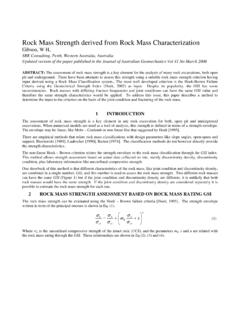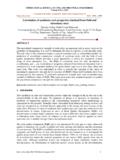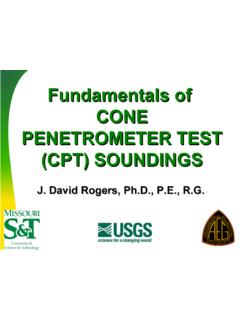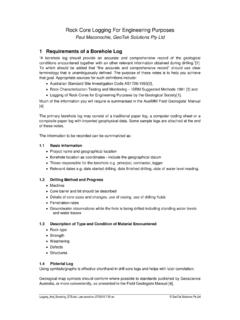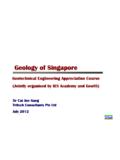Transcription of Rock Engineering Practice & Design - ISRM
1 Rock EngineeringRock EngineeringPractice & DesignPractice & DesignLecture 3: Lecture 3: Rock Mass classification Rock Mass classification & Empirical Design & Empirical Design1 of 40 Erik Eberhardt UBC Geological Engineering ISRM EditionAuthor s Note:Author s Note:The lecture slides provided here are taken from the course Geotechnical Engineering Practice , which is part of the 4th year Geological Engineering program at the University of British Columbia (V C d ) Th k ii d (Vancouver, Canada). The course covers rock Engineering and geotechnical Design methodologies, building on those already taken by the students covering Introductory Rock Mechanics and Advanced Rock Mechanics Rock Mechanics. Although the slides have been modified in part to add context, they of course are missing the detailed narrative that accompanies any l l d h h l lecture. It is also recognized that these lectures summarize, reproduce and build on the work of others for which gratitude is extended.
2 Where possible, efforts have been made to acknowledge th v ri us s urc s ith list f r f r nc s b in pr vid d t th the various sources, with a list of references being provided at the end of each lecture. Errors, omissions, comments, etc., can be forwarded to the 2 of 40 Erik Eberhardt UBC Geological Engineering ISRM EditionErrors, omissions, comments, etc., can be forwarded to the author at: Systems in DesignClassification Systems in DesignEven with many resources available for site investigation, there still can remain problems in applyingtheories in practical Engineering circumstances. Considering the three pgggmain Design approachesfor Engineering rock mechanics analytical, observational and empirical, rock mass classificationstoday form an integral part of the most d i di h h iil di hd predominant Design approach, the empirical Design method. Indeed, on many underground construction, tunnelling and mining projects rock mass classifications have provided mining projects, rock mass classifications have provided the only systematic Design aidin an otherwise haphazard trial-and-error of 40 Erik Eberhardt UBC Geological Engineering ISRM EditionFailure MechanismsFailure Mechanismsstructurally-controlled flrock mass failureThe Stability of an underground opening is a function of:failure Stresslow or highflow or high Structuref lli falling sliding98) Rock MassHoek (194 of 40 Erik Eberhardt UBC Geological Engineering ISRM EditionRock Mass ClassificationRock Mass ClassificationThe objectives of rock mass classifications are to: Identify the most important parameters influencing the rock k f f l h Divide a rock mass formation into groups of similar behaviour.
3 Provide a basis for understanding the characteristics of each rock mass class. Relate experiences of rock conditions at one site to those at another. Derive quantitative data and guidelines for Engineering boundaries of the structural regionsusually coincide with a major Provide a common basis for communication between geologists and boundaries of the structural regionsusually coincide with a major structural feature such as a fault or with a change in rock type. In some cases, significant changes in discontinuity spacing or characteristics, within the same rock type, may necessitate the division f th k i t b f ll t t l i5 of 40 Erik Eberhardt UBC Geological Engineering ISRM Editionof the rock mass into a number of small structural Mass ClassificationRock Mass ClassificationThese objectives suggest the three main benefits of rock mass classifications: Improving the quality of site investigations by calling for the minimum input data as classification Providing quantitative information for Design purposes.
4 Ebli b i i jd d ff i Enabling better Engineering judgment and more effective communication on a of 40 Erik Eberhardt UBC Geological Engineering ISRM EditionRock Mass classification : RMRRock Mass classification : RMRThe Rock Mass Rating The Rock Mass Rating (RMR) system was developed in 1973 in South Africa by Prof. k h d Bieniawski. The advantage of his system was that only a few basic parameters relating to the geometryrelating to the geometryand mechanical conditionsof the rock mass were adjustments are gjmincluded to account for the adverse nature discontinuity angles may have with respect to the excavation orslope 7 of 40 Erik Eberhardt UBC Geological Engineering ISRM (1989)Rock Mass classification Rock Mass classification --RMRRMRTh dj t d li th fi l RMR l f th k m f hi h The adjusted valuegives the final RMR value for the rock mass, for which several rock mass classesare lFor example:A mudstone outcrop contains three fracture sets.
5 Set 1 comprises bedding planes; these are highly 14161 RMR = 6+R2+R3+R4+R5bedding planes; these are highly weathered, slightly rough and continuous. The other two sets are jointing; both are slightly weathered and slightly rough The strength of 4681012 RMR Rating Rand slightly rough. The strength of the intact rock is estimated to be 55 MPa with an RQD of 60% and a mean fracture spacing of m. The fractures are observed to be damp02050100150200250300 Unconfined Compressive Strength, qu (MPa)R8 of 40 Erik Eberhardt UBC Geological Engineering ISRM Editionfractures are observed to be & Hudson (2000)Rock Mass classification Rock Mass classification --RMRRMRE xample:A mudstone outcrop contains three fracture sets. Set 1 comprises 152025ting R2 RMR = 6+12+R3+R4+R5bedding planes; these are highly weathered, slightly rough and continuous. The other two sets are jointing; both are slightly weathered 0510 RMR Ratand slightly rough. The strength of the intact rock is estimated to be 55 MPa with an RQD of 60% and a mean fracture spacing of m.
6 The 0 102030405060708090100 Rock Quality Designation, RQD25fractures are observed to be Rating Spacing (meters)RMRMR = 6+12+10+R4+R59 of 40 Erik Eberhardt UBC Geological Engineering ISRM EditionJoint Spacing (meters)Harrison & Hudson (2000)Rock Mass classification Rock Mass classification --RMRRMRE xample:A mudstone outcrop contains three fracture sets. Set 1 comprises b ddi l th hi hl 253035R4 SlightlyRough/UnweatheredRMR = 6+12+10+(15 to 20)+R5bedding planes; these are highly weathered, slightly rough and continuous. The other two sets are jointing; both are slightly weathered d li htl h Th tth f 10152025 RMR Rating RSlightly Rough WeatheredSlickensided Surface or Gouge-FilledSets 2 & 3 Set 1and slightly rough. The strength of the intact rock is estimated to be 55 MPa with an RQD of 60% and a mean fracture spacing of m. The ft b d t b d050123456 Joint Separation or Gouge Thickness (mm)RSoft Gouge-Filledfractures are observed to be = 6+12+10+(15 to 20)+10 RMR* = 53 to 5810 of 40 Erik Eberhardt UBC Geological Engineering ISRM EditionHarrison & Hudson (2000)Rock Mass classification : QRock Mass classification : Q--SystemSystemThe Q-systemof rock mass classification was developed in 1974 in Norway by Prof.
7 N. Barton. The system was proposed on the b i f l i f 212 tl hi t if Sdii basis of an analysis of 212 tunnel case historiesfrom Scandinavia.. the motivation of presenting the Q-value in this form is to provide some method of interpretation for the 3 constituent of 40 Erik Eberhardt UBC Geological Engineering ISRM EditionRock Mass classification : QRock Mass classification : Q--SystemSystemThe first quotientis related to the rock mass geometry. Since RQD generally increases with decreasing number of discontinuity sets, the gy,numerator and denominator of the quotient mutually reinforce one second quotientrelates to inter-block shear strength with high values representing better mechanical quality of the rock mass. The third quotientis an environment factor incorporating water pressuresand flows, the presence of shear zones, squeezing and swelling rocks pf ,qg gand the in situstress state. The quotient increases with decreasing water pressure and favourable in situstress of 40 Erik Eberhardt UBC Geological Engineering ISRM EditionRock Mass classification Rock Mass classification ExamplesExamples massive, strong rock l t im low stress regime note lack of ground supportpp RMR = 90 (very good rock) Q = 180 (extremely good rock)Courtesy-GolderAssociates13 of 40 Erik Eberhardt UBC Geological Engineering ISRM EditionCourtesy-GolderAssociatesRock Mass classification Rock Mass classification ExamplesExamples blocky rock low stress regimelow stress regime minimal but systematic ground support RMR = 70 (good rock) Q = 15 (good rock)
8 Courtesy- Golder Associates14 of 40 Erik Eberhardt UBC Geological Engineering ISRM EditionRock Mass classification Rock Mass classification ExamplesExamples weak/foliated rock low stress regime note lack of ground supportsupport RMR = 40 (poor to fair rock) Q = ( to poor rock)Courtesy-GolderAssociates15 of 40 Erik Eberhardt UBC Geological Engineering ISRM EditionCourtesyGolderAssociatesRock Mass classification Rock Mass classification ExamplesExamples massive, strong rock extremely high stress regime rockburst failure complete rockburst failure, complete closure of drift, extremely heavy support, screen retains failed rock RMR = 80 (good to rock) Q = (very poor rock)Courtesy- Golder Associates16 of 40 Erik Eberhardt UBC Geological Engineering ISRM EditionRock Mass classification Rock Mass classification ExamplesExamples blocky rock high stress regime RMR = 40 ( t fi k)(poor to fair rock) Q = (very poor rock)(yp)Courtesy- Golder Associates17 of 40 Erik Eberhardt UBC Geological Engineering ISRM EditionApplication of classification SystemsApplication of classification SystemsBoth of the classification systems described were developed for estimating developed for estimating the supportnecessary for tunnels excavated for civil Engineering Engineering example, the database for the RMR has involved over 351 case historiesthroughout its development.
9 Bieniawski (1989)Bieniawski (1989)18 of 40 Erik Eberhardt UBC Geological Engineering ISRM EditionExperienceExperience--Based Design : Empirical ApproachesBased Design : Empirical 38 different support categories have been suggested by Barton (1974) based on the relationship between the Q index and the equivalent dimension of the excavation 19 of 40 Erik Eberhardt UBC Geological Engineering ISRM Editiondimension of the excavation. ExperienceExperience--Based Design : Empirical ApproachesBased Design : Empirical Approaches20 of 40 Erik Eberhardt UBC Geological Engineering ISRM EditionKaiser et al.(2000)Subjectivity in Empirical Design Subjectivity in Empirical Design --JRCJRCBeer et al.(2002)21 of 40 Erik Eberhardt UBC Geological Engineering ISRM EditionSubjectivity in Empirical Design Subjectivity in Empirical Design -- UndersamplingUndersamplingIt t b b d th h th t h id li d It must be remembered though, that such guidelines are drawn from previous experiences ( case histories) and are therefore limitedby the range of conditionsunder which these experiences were generated were generated.
10 Bieniawski (1989)22 of 40 Erik Eberhardt UBC Geological Engineering ISRM EditionBieniawski (1989)Rock Mass Characterization Rock Mass Characterization of 40 Erik Eberhardt UBC Geological Engineering ISRM EditionRock Mass Properties Rock Mass Properties --StrengthStrengthRemember!! we re now talking about rock mass talking about rock mass failure, not structurally controlled )ie & Mah (2024 of 40 Erik Eberhardt UBC Geological Engineering ISRM EditionWyllMohrMohr--Coulomb Failure CriterionCoulomb Failure CriterionThe MohrCoulomb failure criterion expresses the relationship between The Mohr-Coulomb failure criterion expresses the relationship between the shear stress and the normal stress at failure along a shear (1997)son & Harris25 of 40 Erik Eberhardt UBC Geological Engineering ISRM EditionHudsProblems with MohrProblems with Mohr--CoulombCoulombAlth h th M hC l b f il it i i f th t Although the Mohr-Coulomb failure criterion remains one of the most commonly applied failure criterion, and is especially significant and valid for discontinuities and discontinuous rock masses, several key limitations apply to rock slope stability analyses.


